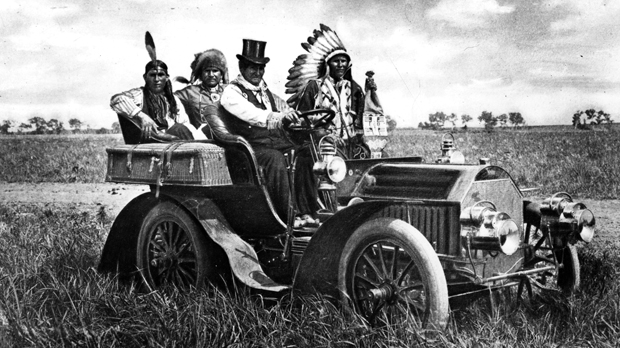Target bin Laden: why was he code named ‘Geronimo’?
The Americans chose the code name of a Native American warrior chief in the operation to kill Osama bin Laden. But, as Samira Ahmed writes, Geronimo did more than evade capture – he became a hero.

It is what you shout when take a dangerous leap; a slogan of US paratroopers during the second world war.
But the 19th century Chiricahua Apache hero, whose name it is, was a perhaps questionable choice of code name for Osama Bin Laden; given the numbers of people who do regard him as a hero. His story is laden with symbolic parallels for those who choose to regard Bin Laden as a great warrior.
Born Goyahkla (He Who Yawns) in modern New Mexico in 1829, he was given the name Geronimo by Mexican soldiers, who prayed to St Jerome, after seeing him defy bullets to attack with a knife.
His desire for revenge against the Mexicans was fuelled by their massacre of his mother, wife and three children. He was a symbol of resistance – the man who defied the White Man’s broken treaties, who refused to remain quietly on a reservation when other tribes had given in and been forced off their tribal lands.
Geronimo famously said he was not a chief, a political leader. Instead, like Bin Laden, he saw himself as a military leader.
Bin Laden’s fundamental hatred against the west was supposedly the US presence on holy (and oil-rich) Saudi Arab soil. In the 1860s, the discovery of Gold in the West saw the US and the Mexican governments speed up their push against American Indians to seize their land.
Geronimo became a great war leader, a symbol of resistance to the white occupation. His small band of warriors raided settlements in Arizona, and attacked US troops.

(Geronimo, in the top hat, driving a motor car in Oklahoma, 1908 – Getty)
As the US looks to withdrawal from Afghanistan, and the possibility of negotiating with the Taliban, it’s worth noting that he was rarely defeated and US generals found themselves struggling to form a successful strategy.
The last of the Indian wars ended after years, only when Geronimo signed a piece treaty with General Nelson Miles – who had failed to defeat him by military means.
The end of Geronimo was a humiliation of broken promises, not assassination.
As a result of the revisionist histories written since the 1960s, many younger Americans, such as President Obama, would, surely be aware of the less than honourable actions of US forces against American Indians, such as Geronimo.
He and his people were moved around Florida, and Alabama, ending up in Oklahoma. He was not killed in a compound; but died in US military base – Fort Sill in 1909, after completing his autobiography.
Even in the early 1960s, when we assume Indians were the “bad guys”, Hollywood’s first biopic starring the white sportsman turned actor Chuck Connors as the Native Indian hero, saw him portrayed as a great hero and family man, abused by Federal forces.
The 1993 film Geronimo: An American Legend, starting Gene Hackman, Robert Duvall and the Native American Wes Studi as Geronimo, focused on the abuse of the Apache themselves and the success of a small band of dedicated warriors against the might of the US military.
According to some analyses today, the US military chose the code name because Bin Laden, like Geronimo, had evaded capture for years. If they were trying to avoid mythmaking, it seems they chose the wrong code name.
-
Latest news
-
Are Labour and Tories in election mode? | The Political Fourcast35m

-
Boy with profound learning disabilities reaches out of court settlement after abuse in residential school7m

-
India election: Modi rivals hit by string of raids and arrests7m

-
Can UK’s abandoned mines be used to build a greener future?5m

-
Sycamore Gap: Man pleads not guilty to felling iconic tree2m

-




